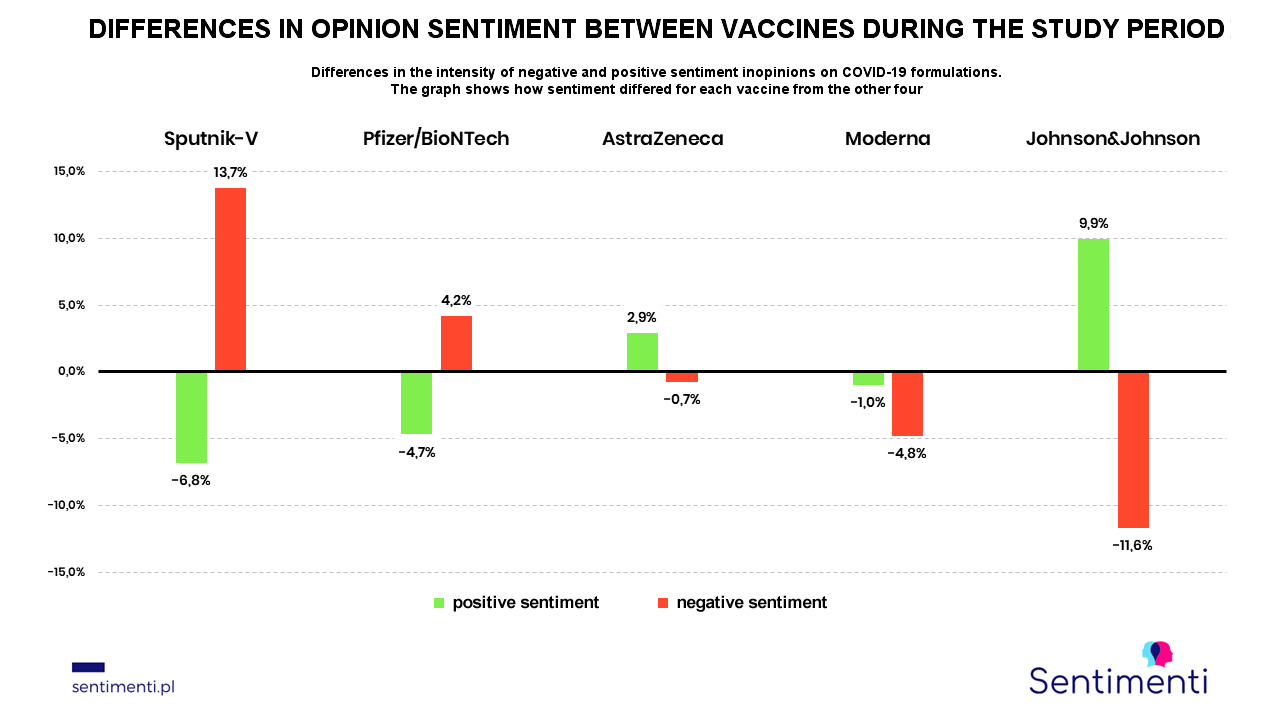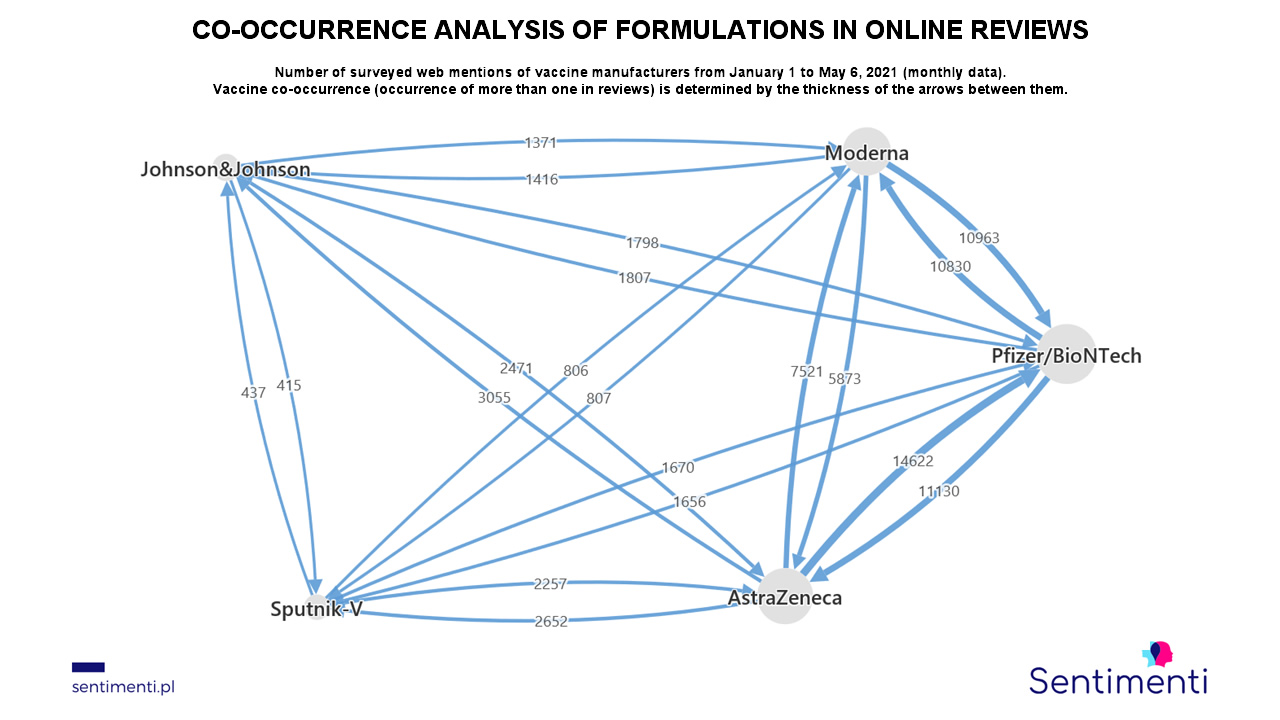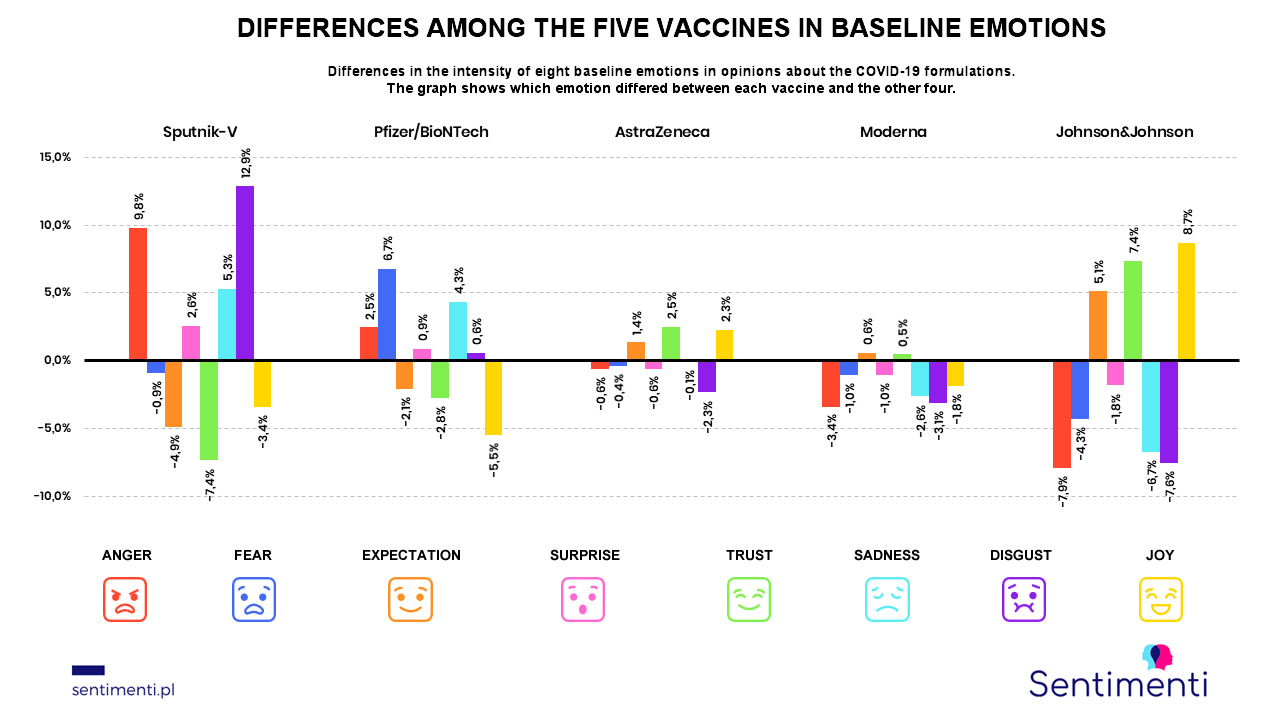
by Damian Grimling | Nov 6, 2021 | Sentimenti research
When sentiment analysis began to be used for marketing activities in the early 2000s, it opened up vast opportunities for the marketing and advertising industries. Understanding consumer sentiment allowed for better validation of actions and more precise targeting of target groups. Today, 20 years later, new doors are opening—rather than just measuring sentiment, we can now analyze emotions, and this offers even more benefits. What are they?
FROM THIS ARTICLE, YOU WILL LEARN: |
-
What is the difference between sentiment and emotion? -
What is the difference between sentiment analysis and emotion analysis? -
How do the results of both algorithms look in practice? -
Emotion analysis is not only effective in content marketing -
Perspectives on the development of emotion analysis tools |
Differences Between Sentiment and Emotions: Full List of Emotions
First, let’s define sentiment and emotions—the most important differences arise at this basic level because sentiment and emotions are two distinct phenomena.
-
- Sentiment is the state in which a person experiencing emotions can name what they are feeling, connect that experience with thoughts about it, and then make a conscious decision regarding the source of the stimulus. Sentiment, therefore, is the sum of physiological reactions (from the body) and cognitive processes triggered by the experience of emotions. Since it is a conscious state, it can be sustained by the person experiencing it. In general, sentiment is a broad mental attitude towards a particular experience.
- Emotions, on the other hand, are the physiological and, consequently, psychological brain responses to an external stimulus or an experience related to such a stimulus. The combination of the experience and the body’s reaction (hormonal activity) causes a short-lived and unconscious state, leading to specific actions such as fight, flight, freeze, awe, disgust, etc. What’s more—each emotion is tied to a different type of reaction, resulting in different behaviors.
As you can see, without experiencing emotions, you cannot enter a state of sentiment. Emotions operate at the lowest, behavioral level, while sentiment is their reflection, consideration, and evaluation by the person experiencing them. Emotions cause spontaneous reactions, while sentiment leads to conscious and controlled actions. The most significant difference: there are only eight basic emotions (according to Plutchik’s theory: joy, sadness, anger, fear, disgust, surprise, anticipation, and trust), which, when combined, form secondary, higher emotions that lead to the creation of feelings. In the case of sentiment, we are dealing only with positive and negative sentiment, sometimes also neutral.
Exploring Emotions: Media Monitoring vs. Sentitool – A Tool Comparison
Just as the phenomena of sentiment and emotions differ, so do the tools used to analyze them. These tools leverage advanced technologies such as neurolinguistic programming, machine learning, and other AI algorithms. Currently, in the Polish market for sentiment analysis in online content, several reputable companies exist, but in the field of emotion analysis, only one stands out as a true pioneer—Sentimenti. Below is a comparison of the general capabilities of sentiment and emotion analysis tools.
| |
-
examining the general tone of statements made by Internet users, article authors, etc. -
determine the user's impression and attitude after reading the text -
ease of processing and estimation of analysis results -
Useful for evaluating online brand mentions, social media management and customer communications, including complaint handling -
crisis communication support -
comparing consumer attitudes toward our own and competitors' products | -
to examine the instinctive reactions of Internet users and the intentions of the creators -
The ability to get to the emotions behind a particular sentiment and determine the future actions of those commenting -
Much greater range of information collected (8 emotions, sentiment analysis and emotional arousal) -
ability to work on huge groups of respondents -
assessment of consumer sentiment before and after the advertising campaign -
validation of marketing strategies -
monitoring emotions about the company in online mentions -
-
comparing brand perceptions -
analysis of emotions associated with influencers, YouTubers, bloggers, etc. to accurately select a brand ambassador |
Conclusion: The common (even within the industry) usage of the terms sentiment analysis and emotion analysis is incorrect. Sentiment is a much narrower concept, indicating in practice only the tone of a statement and possibly the mood of the author. Emotion analysis, on the other hand, describes the level of individual emotions (providing a percentage result for eight components, as well as the type of sentiment and the level of emotional arousal); with this data, consumer reactions and behaviors can be predicted with high accuracy.
As you can see, this data is more detailed; its analysis is more challenging, but it is also more accurate and comprehensive. Sentimenti’s algorithm includes as many as 30,000 words and phrases collected from a group of 22,000 people. The algorithm itself was developed in collaboration with the Wrocław University of Science and Technology and the Brain Imaging Lab of the Polish Academy of Sciences.
How Do the Results of Both Algorithms Look in Practice?
Time for some practice! Take a look at the following analysis of a real review:
I will never buy anything from smelly V(…) again. I recently decided I didn’t want to buy tragic clothes from chain stores, so I bought from there, and the supposedly perfect condition item, without signs of wear, had a stain that was visible. The woman claims that when she sent it, the stain wasn’t there.
This review is authentic and taken directly from a portal. What can you read from it when measuring sentiment versus emotion?
Results: Anger – 70%, Fear – 45%, Anticipation – 24%, Surprise – 57%, Trust – 14%, Sadness – 60%, Disgust – 62%, Joy – 10%, Positive sentiment – 10%, Negative sentiment – 70%, Emotional arousal – 72%.
The comment comes from a disappointed customer who, instead of making a purchase from one of the popular boutiques, opted for what she considered higher-quality used clothes. The purchase turned out to be unsuccessful, and the item was stained despite being described as in good condition. The buyer is clearly upset (emotional arousal at 72%), angry (a high 70%), feeling disgust (62%) and sadness (60%)—as she expected a good purchase. Notice that the woman also exhibits a high level of surprise (57%) and fear (45%)—when you add the disgust result, you can understand that this is her physical reaction to the experience of being deceived.
Now look at the same review from a sentiment analysis perspective: you receive two results—negative (70%) and positive (10%). The negative sentiment is evident even without automatic analysis, given phrases like smelly, tragic, stain, woman. The phrases supposedly perfect condition and without signs of wear build the low positive sentiment score.
The key information, however, is hidden—the phrase smelly refers directly to the shopping platform, tragic to the quality of chain store clothes, and woman to the seller. The overall tone of the review is set by the epithets unrelated directly to the purchased item, yet the sentiment analysis result remains negative.
Conclusion: With percentage results for basic emotions and knowledge of the typical physiological reactions they correspond to, you can estimate consumer behavior in this situation. Anger is associated with an attack response (hence the comment on the portal), disgust and fear with flight, and sadness with freezing. The emotional consumer will likely switch to another platform or opt for in-person shopping. She will probably not use this platform again.
Emotion Analysis is Effective Beyond Content Marketing
You’ve just seen how sentiment and emotion analysis results are interpreted in a specific example, and what kind of insights you can gain from them. As you’ve likely noticed, emotion analysis is a far more comprehensive, complete solution tailored to customer needs. But are emotion analysis algorithms limited to marketing, PR, or customer service?
Definitely not. With the development of machine learning technology and the implementation of increasingly sophisticated AI algorithms, the possibilities of emotion analysis extend into other industries. Today, emotions can be analyzed, for example, to forecast stock market prices or investment opportunities in the cryptocurrency market.
Future Prospects for Emotion Analysis Tools
If the above information hasn’t convinced you of the superiority of emotion analysis over sentiment analysis, look at the development potential of the former. Artificial intelligence is already highly advanced. Today, AI is being implemented not only to study but also to create emotionally engaging content aimed at achieving set goals.
These goals include increasing conversion rates from marketing activities, acquiring more effective leads, or providing customer service tailored to consumer needs (including potential crisis situations and ways to avoid them). The latter goal significantly improves user experience, increasing customer loyalty to the brand, which, in turn, strengthens the brand’s position in the market. That’s the potential of this technology—sentiment analysis can’t do that.

by Damian Grimling | Nov 6, 2021 | Categorising comments, SentiBrand
Shopping is a constant part of our lives. Every day, we come into contact with a huge number of more or less recognizable brands and companies. However, only some of them we choose more often and more willingly. Sometimes it happens completely automatically. Why does this happen and what determines our choice? It is probably emotions.
Brand loyalty vs. brand strength. What determines our choice?
There’s no denying and it’s been proven that our purchasing decisions are mostly influenced by emotions and the bond that a brand has developed with us. A recent study conducted by Deloitte entitled “From disparate signals to transformative action. The latest research by Deloitte “From disparate signals to transformative action” shows that emotional attachment to a brand is a decisive factor when making purchases for a group of 80% of consumers. In turn, 62% of them declared that they have some kind of relationship with a given brand.
– The brand-consumer relationship is a particularly important factor in sales strategy because it is directly related to customer satisfaction. We as manufacturers are constantly challenged to create better and better offers that meet consumer expectations,” – reads the report.
For what purpose do we shop? Consumers often shop primarily to improve their mood. Nowadays, the purchase of a particular good or service does not have to be dictated by discounts, promotions or low prices. The key here is the mentioned emotions. They are the reason why some of our purchasing decisions are not very rational, made on impulse and at the moment.
So, what can a brand do to generate emotions and become even more liked and recognized by consumers? What is the secret and power of the biggest brands and their messages? Apart from emotions, it is important to build positive associations in the recipients. It is worth remembering to adjust the communication strategy to the target group. An advertising campaign addressed to teenagers should look different from one addressed to people aged 40+.
Visual identity also plays a huge role in consumers’ perception of a brand. We live in a world of short information, slogans and signs. That is why logos, colors, symbols and general aesthetics of products are important. All this also creates the image of the company according to the buyer and has a bearing on building a relationship between him and the brand.
The basis is brand loyalty and trust
Today’s market abounds in various brands, and more and more are created all the time. We are almost flooded with various products and symbols, often not knowing what it all means. However, companies that enjoy the greatest recognition and consumer choice are not resting on their laurels and are constantly developing their offers. The key is to constantly work on the image because without this, it is impossible to maintain the leadership position.
In the aforementioned Deloitte report we read that if a brand wants not only to stay on the market, but above all to boast of constant trust, it needs constant work and listening to consumers. This means staying up to date with the ever-present changes and new trends. Without this, it will not be possible to maintain the highest standards and respond to the preferences of as many customers as possible.
The consumer who has established a bond with the brand is then not only a recurring generator of profit, but also an engaged recipient. Building long-term partnerships with consumers means, above all, responding responsibly and effectively to their needs. More and more companies emphasize personalization and considering individual preferences of consumers to provide them with the most suitable benefits.
Many factors contribute to the choice of a particular brand, but first there are positive emotions and associations. To build them, we need a dialogue with consumers, a trusting answer to their needs as well as building the opinion of a unique brand, positively distinguishing itself from the competition. We can easily learn about emotions by analyzing media, including blogs, news portals, internet forums and most of all social networking sites. That’s what Sentimenti tools are for.

by Damian Grimling | Aug 5, 2021 | Politics and Social
This is undoubtedly one of the most commented political topics of recent weeks. Lex TVN. What it is. It’s a parliamentary draft of amendments to the media law, the proceedings of which coincided with the expiration of the license to broadcast the TVN24 television station. Is the topic heating up citizens online? If so, how much?
Lex TVN. What is it about and how do Internet users react?
- The TVN24 station, according to the new law, may not get its 10-year broadcasting license renewed,
- The topic has been one of the most popular in recent weeks and has been strongly agitating Internet users,
- Emotions are rising as soon as one remembers that the whole issue is being watched personally by US President Joe Biden.The topic of the concession to the TVN24 station stirs emotions, as evidenced by the high emotion arousal of Internet users. We examined the discussion of the so-called Lex TVN across the web (not only social media, but also comments under editorials and on forums and blogs and elsewhere). This is a total of almost 180,000 opinions of Internet users. The chart below illustrates the number of statements on the subject online and the average daily intensity of emotional arousal. The values of this indicator for the entire analyzed period, i.e. from July 8 to August 2 this year, were higher than 50%.

The topic of the TVN24 station’s concession stirs emotions, as evidenced by the high emotional arousal of Internet users. We examined the discussion of the so-called Lex TVN across the web (not only social media, but also comments under editorials and on forums and blogs and elsewhere). This is a total of almost 180,000 opinions of Internet users. The chart below illustrates the number of statements on the subject online and the average daily intensity of emotional arousal.

Contexts of negative discussion on Lex TVN
As is standard with the topic of media repolonization, the key contexts for negative discussion are: free media, freedom of speech, independent media. A lot of discussion was devoted to foreign capital in the media (here, too, the context is about private business, the civilized world, the owner of TVN). However, the citizen’s right to access the media and to reliable information was pointed out. As standard, criticism went in the direction of the ruling party, the public media were slashed (context: propaganda tube, brainwashing, dark people). Also standard in this type of discussion is extensive reference to other current policy issues. This is another typical clash of tribes in the digital world.

In terms of discussion venues, we recorded the most anger on news portals, i.e. in conversations among Internet users under editorials (level of almost 40%). The most joy, on the other hand, appeared on Facebook. There, many posts and content were published under which people cheered the opposition in taking action to defend their favorite TV station.

In general, however, the dominance of negative emotion is noticeable in all media, although the level of emotion saturation = 50% was not exceeded in any of the sources.
Conclusions
In 2020. Poland has dropped as many as 11 positions on the list of the strongest national brands (Soft Power Index). It seems that Lex TVN is another unnecessary and potentially dangerous image crisis for the country. Such events have a direct impact not only on polarizing citizens and fueling further conflicts. They cause more tangible losses – declines in the rankings of the strongest brands-countries (e.g., Country Index, in which Poland fell 11 notches to position 55 in 2020). The situation around Lex TVN – even if it’s just a holiday substitute topic – could scare off potential investors and damage our foreign policy.
From the point of view of surveys of conversations among Internet users, this is another topic in a whole sea of political topics to stir up the electorate online. It can also be a completely surrogate issue, thrown in by politicians for the vacation season to stoke extreme emotion. There is also no denying that the topic has somewhat run out of steam in recent days.
The defense, according to the opposition, of the so-called “free media” does not break through as strongly in the online world. The issue can also be considered on another level. The ruling party has a plan to win the next election. It can do this with TVN24 (it has succeeded many times), but it may not succeed in the absence of Internet control. Perhaps the next installment of the battle for control in the media will be in this space. The station, which is the subject of Lex TVN, will become a forbidden fruit once the new law is passed. This means that its popularity – contrary to the assumptions of the new law – is likely to soar.

by Damian Grimling | May 10, 2021 | SentiBrand
The topic of vaccines, and specifically the differences between them, arouses great emotion. Analysis of Google search phrases shows that the public is still looking for information on the differences between preparations of different manufacturers. “Which vaccine to choose?”, “Moderna or Pfizer?” – are just some of them. This time we took to the workshop conversations of Internet users about five preparations. We explored the emotions and sentiment between them to see how they differ.
Pfizer or Moderna, or which vaccine to choose?
The material analyzed by our team represents a total of nearly 190,000 mentions of five vaccine manufacturers between January 1 and May 6, 2021. Content about specific manufacturers was filtered out of discussions about COVID-19 vaccines overall. Using the SentiTool tool, it only took a few minutes to get the full results.
Preparations were most often discussed by Internet users under articles on news sites. The second place in terms of discussion sites was Twitter, followed by Facebook. On news portals, Internet users discussed AstraZeneca most often. This is also where a lot of opinions about the Sputnik-V vaccine from Russia were reported online. On Twitter and Facebook, but also in other places, it was Pfizer. These two vaccines are among the most commented on.
 The graph of discussion dynamics (monthly data) shows that the AstraZeneca controversy has had its effect. This vaccine was discussed very intensively – most often in March this year. Johnson&Johnson was the least discussed. It is worth noting that in a significant number of opinions there were more names of preparations.
The graph of discussion dynamics (monthly data) shows that the AstraZeneca controversy has had its effect. This vaccine was discussed very intensively – most often in March this year. Johnson&Johnson was the least discussed. It is worth noting that in a significant number of opinions there were more names of preparations.

COVID-19 vaccines – a comparison. Sentiment and emotion
When looking at the differences in sentiment of opinion of a given vaccine versus the others, two extremes are clearly visible. Johnson’s was the most positively commented on during the study period. In contrast, the most negative statements were reported around Sputnik-V. The controversy around vaccine reactions after AstraZeneca’s vaccine ultimately did not impair the online image. More unfavorable content was seen from Pfizer, which may come as a surprise.
DIFFERENCES IN OPINION SENTIMENT BETWEEN VACCINES DURING THE STUDY PERIOD
Differences in the intensity of negative and positive sentiment inopinions on COVID-19 formulations. The graph shows how sentiment differed for each vaccine from the other four

This preparation is one of the most popular among Poles and it is with this preparation that citizens most often want to be vaccinated. This may have been influenced by the co-occurrence of other preparation names together with Pfizer. This is because we are primarily examining the general climate of online discussion around the products of pharmaceutical companies. Thus the graph below shows how opinions on one preparation could have influenced the discussion climate around another preparation on the basis of co-occurrence. Moderna and AstraZeneca co-occurred most frequently with Pfizer.
Co-occurrence analysis of formulations in online reviews

The chart below breaks the positive and negative sentiment into eight base emotions for an even closer look at vaccine opinions. Sputnik-V differed from the other formulations with a high dose of disgust (about 13% more than the others) from internet users, while Pfizer differed with fear and sadness. AstraZeneca reported a slight increase in confidence and expectation. With the same emotions, single-dose Johnson differed from the rest most on the plus side (with strong decreases in negative emotions relative to competitors). As for Moderna, there is little difference from the other four formulations against COVID-19.

The above analysis is illustrative and informative. It does not reflect the full results of the study.













